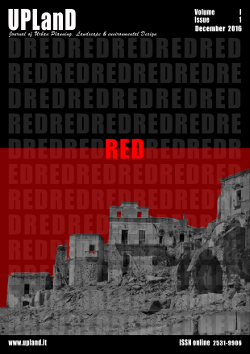Climate risk, Environmental planning, Urban design
Main Article Content
Abstract
The vulnerability of the territory and of urban districts and buildings is systemic and related to specific hazard and to the level of exposure of people and economic assets. Among the environmental risks, climate risk has multiple interpretations. The sources of the governmental organizations and scientific institutions indicate that the growing influence on the climate and the earth's temperature depend on the increasing emissions of greenhouse gases. The main international strategies are addressed in the medium and long term to establish mitigation of the causes that induce dangerous impacts in relation to the degree of vulnerability of contexts. The identification of local vulnerability, risks and activation of local resources, useful to improve the resilience and adaptive capacity, represent the link between the scale of urban planning and a more detailed scale, in which act through strategies "Climate-smart" in technological innovation and environmental design of buildings and open spaces system. Environmental design fits into the panorama of architectural design with the aim to define the boundaries and determine limits and goals related to the complex relationship between inhabitants and environment. In the field of new dwelling, but also in buildings and open spaces rehabilitation, the systemic and performance approach integrates the emerging scenarios of the digitization of built environment sector, that combine greater efficiency for the project and for the building process, developing preventive checks of the aspects of technical and performance simulation control.
Downloads
Article Details

This work is licensed under a Creative Commons Attribution-NonCommercial-NoDerivatives 4.0 International License.
Authors who publish with this journal agree to the following terms:- Authors retain copyright and grant the journal right of first publication with the work simultaneously licensed under a Creative Commons Attribution License that allows others to share the work with an acknowledgement of the work's authorship and initial publication in this journal.
- Authors are able to enter into separate, additional contractual arrangements for the non-exclusive distribution of the journal's published version of the work (e.g., post it to an institutional repository or publish it in a book), with an acknowledgement of its initial publication in this journal.
- Authors are permitted and encouraged to post their work online (e.g., in institutional repositories or on their website) prior to and during the submission process, as it can lead to productive exchanges, as well as earlier and greater citation of published work (See The Effect of Open Access).
References
Conato, F., & Frighi, V. (2016). Metodi della progettazione ambientale. Approccio integrato multiscala per la verifica prestazionale del progetto di architettura. Milano, IT: Franco Angeli Editore.
Dierna, S. (1995). Tecnologie del progetto ambientale. Per una trasformazione sostenibile degli aspetti insediativi. In Teaching in Architecture Energy and Environment World Network, Proceedings of the Florence International Conference for Teachers of Architecture, Firenze, September 28-30, 1995.
European Commission. (2016, November 22). Climate Action. Retrieved from http://ec.europa.eu/clima/index_en.
Galderisi, A. (2014). Urban Resilience: a framework for empowering cities in face of heterogeneous risk factors. A| Z Journal-Cities at risk, 11(2).
Regione Lombardia (2015). About concepts of dangerousness and risk vulnerabilities, Directorate-General, Security, civil protection and immigration. http://www.protezionecivile.regione.lombardia.it/
Milanaccio, A. (1998). Dalla lotta all’ inquinamento alla società sostenibile. In P. Ceri e P. Borgna (eds). La tecnologia per il XXI secolo. Prospettive di sviluppo e rischi di esclusione (215-237). Torino, IT: Einaudi.
Pellizzaro, P. (2013). L’adattamento necessario. QualEnergia,1.
Pierce, D. (2015). Resiliency. Retrieved from http://www.cleanenergyresourceteams.org/
Rigillo, M. (2016). Strategie europee per la ricerca e cultura tecnologica del progetto. In M. Gambaro (ed.), La progettazione tecnologica e gli scenari della ricerca. Santarcangelo di Romagna, IT: Maggioli.
Rischio ambientale. (n.d.). In Enciclopedia Treccani. Retrieved from http://www.treccani.it/enciclopedia/rischio-ambientale/
Schiaffonati, F. (2011). La valorizzazione dei beni culturali tra ricerca e formazione dottorale. In AA.VV., Progetto e tecnologie per la valorizzazione dei beni culturali. Quaderni del dottorato PTVBC,1, 11.

